Refining PR strategies is key to making them successful. Even if you’re already a PR Pro.
This article dives deep into advancing your media relations strategies, offering next-level essential tactics specifically designed for experienced public relations professionals.
Use these tips to build stronger bonds with journalists, create press releases that really pop, and snag awesome media coverage that can boost your brand's message.
- Media relations vs public relations
- 6 fundamental media relations strategies
- 6 advanced media relations strategy tactics
- Tip: draft press releases and personalized pitches with AI
- 3 media relations strategy examples
- FAQ: media relations strategy
- A successful media relations strategy
If you are a Pro, you know how important data-based decisions are. Use Prowly to create a data-driven strategy and benefit from it in the long-term.
Media relations vs public relations
Public relations and media relations are like two sides of the same coin. They both are key factors in building a positive reputation for a company. However, they each have distinct focuses:
Public Relations: the big picture
Fine feathers make fine birds, they say.
Public Relations encompass a wide range of activities aimed at managing the public's perception of a company.
PR strategy examples are brand storytelling, social media engagement, crisis communication, and community outreach.
Essentially, public relations strategies are about creating and maintaining a strong and coherent overall image.
P.S. Here’s an article that might come in handy if you’re looking for a tool to measure the impact of your communication efforts.
Media Relations: a targeted effort
Media relations strategies focus specifically on building relationships with journalists and other media outlets.
The goal is to secure positive media coverage for your brand.
Media relations planning usually covers creating press releases, pitching stories, and responding to media inquiries.
You can perceive media relations as bringing your message to the public eye.
💡 P.S. We covered this topic in greater detail in the Media Relations Panel during PR Episodes 2024 that you can now watch on demand.
6 fundamental media relations strategies
To kick off your media relations strategy you should know your options. Below you can find six media relations strategies and tactics. To choose the best media tactics you should keep your target audience and the media outlets they prefer in mind.
#1 Setting strategic goals and objectives
Establish where you are heading first.
The definition of media relations highlights relationships.
But before starting to build them you need to set a SMART goal and objectives. Make these clear and measurable and well aligned with your business objectives.
- A successful media relations strategy should involve benchmarks and competitive analysis.
- By benchmarking performance against industry standards and competitors, you can identify areas for improvement and refine your tactics accordingly (and these tools can help you analyze that).
#2 Understanding audience dynamics
The next media relations strategy example is understanding how your target audience operates.
To truly excel in media outreach, it's essential to delve into audience segmentation and behavior analysis.
- This means you should split your audience into smaller groups based on demographics, interests, and their behaviors.
- This allows you to personalize content and thus resonate with your recipients more.
- You can use some research tools and data analytics to discover audience preferences and design a successful media relations strategy based on them.

Media monitoring and sentiment analysis can be a great help at this point.
#3 Crisis communication action plan
Crises come unexpectedly. To effectively navigate them, it's essential to develop comprehensive communication plans that cover various scenarios and stakeholders. You can read more about it here: PR crisis management.
Another crucial "to-do" on your list should be to establish proactive communication channels with the media for when a crisis arises. And the sooner the better.
- By engaging with journalists and other media outlets early on, you can ensure accurate information flow and mitigate the spread of misinformation.
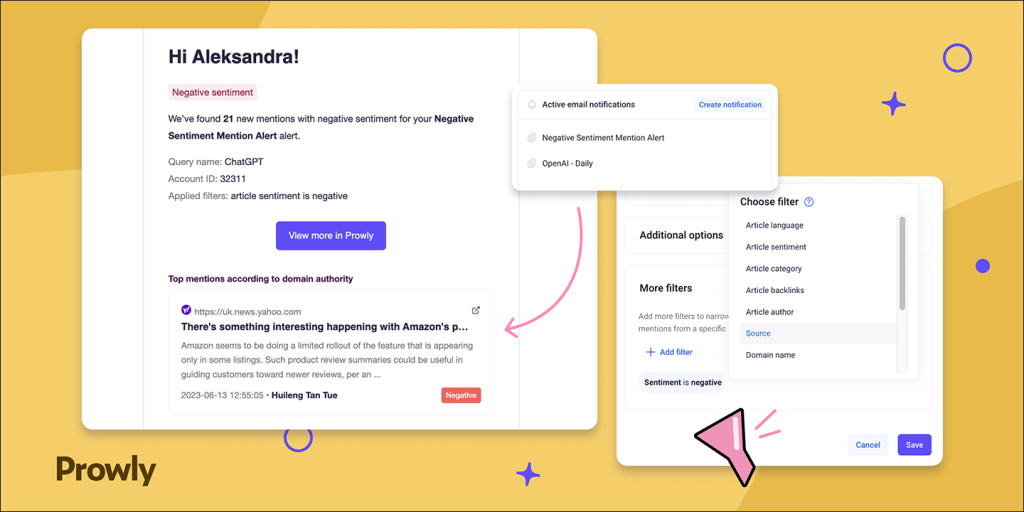
Using a Media Monitoring tool should be an essential part of crisis management strategy as well.
Want to see how real brands handled crises? Explore these 16 PR crisis management examples to learn what worked—and what didn't.
#4 Harnessing technology for media engagement
This step seems to be a must-have since AI tools entered our lives and businesses in the past years.
You can benefit from technology and use AI-powered media monitoring tools, like Prowly's AI assistant.
- They can allow you to track coverage and identify trends.
- They help you write press releases and pitches based on real-time questions (like in the example below).
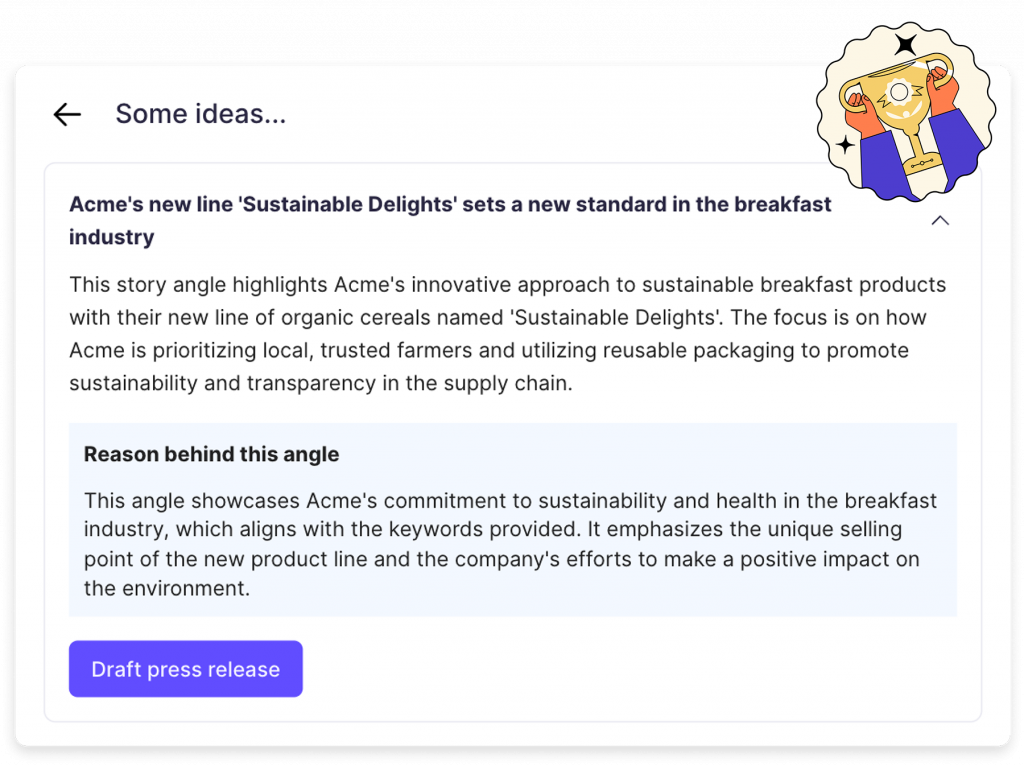
- AI-driven assistants and tools can improve your daily task performance.
- On top of that, there are more and more innovative PR-dedicated platforms, like virtual press conferences and digital newsrooms. These can significantly boost media engagement and outreach.
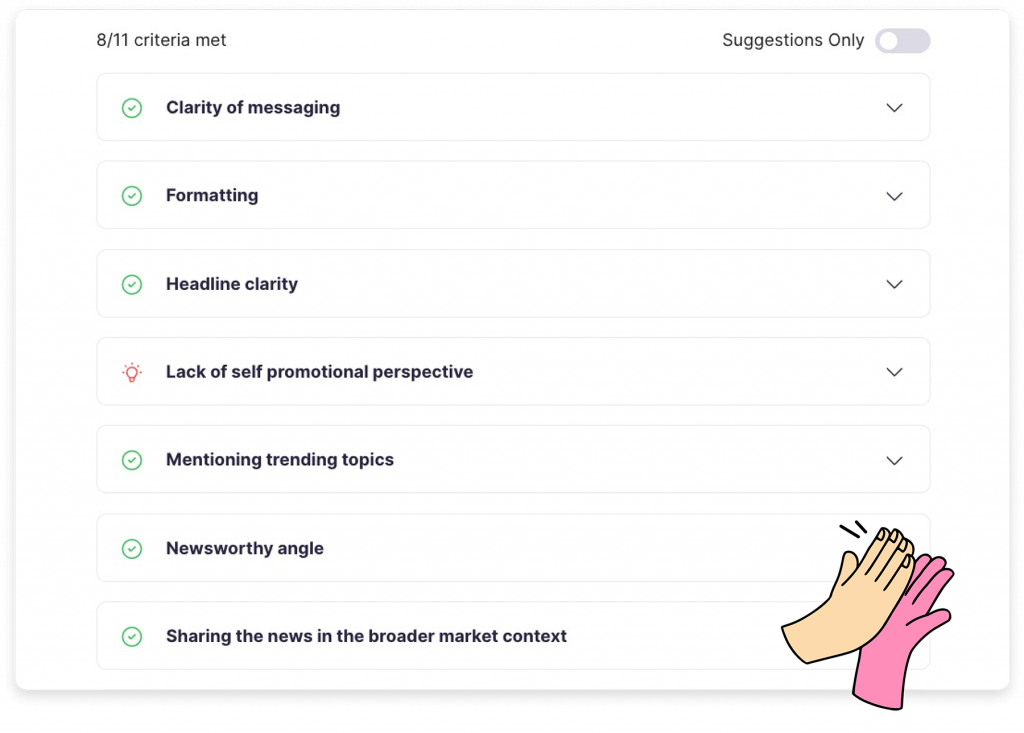
For example Prowly's AI Assistant not only helps refine your content with PR writing best practices for near-publishable quality but also ensures essential details for engaging press releases, like tone, grammar, quotes, and more, are not overlooked.
#5 Building long-term relationships
Now here’s the core of media relations issues and strategies. Relationships.
Focus on cultivating these with journalists – build them on a foundation of trust, transparency, and mutual respect.
✔️ Give them some exclusive insights and access to experts. A behind-the-scenes experience may be a real gem for journalists and push you to the top of their list.
P.S. Nurturing partnerships is one of the biggest PR trends of this year. And it only keeps rising. You can find more info in our article: Top PR Trends and Predictions for 2024.
#6 Customize your pitching and storytelling
Add a special touch and deliver a personalized message to journalists.
✔️ Craft personalized pitches for them and incorporate multimedia, like videos and infographics.
✔️ Leverage a data-driven storytelling to make narratives more compelling and engaging.
Real stories touch people's minds and hearts. It also grants some authenticity. What is more, storytelling is a promising trend for this year.
6 advanced media relations strategy tactics
Now it is time to cover some actions. How do you create tactics that achieve their purpose?
#1 Influencer engagement and co-creation
The social media world is all about influencers, so include them in your campaigns.
Identify the key influencers within your industry and create strategic partnerships. These are beneficial for both sides.
They can co-create content that wins their audience's hearts and speak their mind about your brand simultaneously. Using their credibility and authority, you can amplify your brand's message.
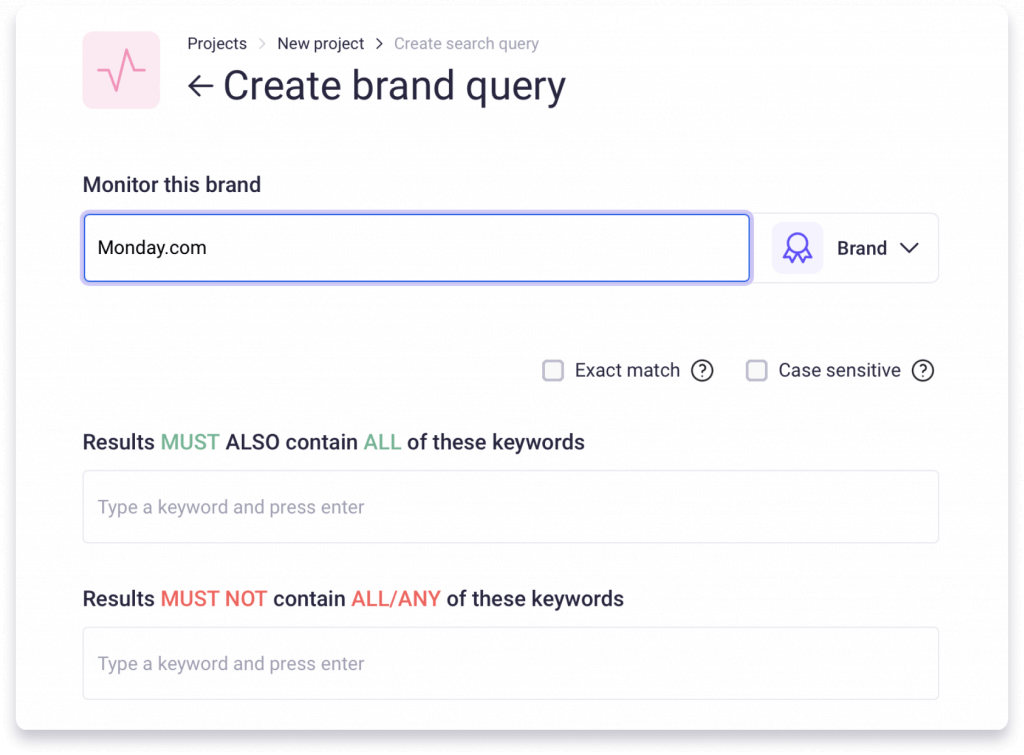
💡 How to do identify influencers and advocates?
Use media monitoring to check who is your advocate and who is recommending your products or services. Sometimes people might not tag you, but media monitoring will show you these results.
👉 Make sure to set keywords with slight grammatical errors as well, because misspells are common and often made unintentionally.
#2 Thought leadership positioning
Another public relations strategy example is positioning your executives and experts as leaders in their fields.
- Create worth-a-listen personas and develop thought leadership content strategies to showcase their expertise and professional perspective.
- Make them stars during industry meetings, conferences, webinars or podcasts. Put them in the spotlight and position your brand as a leading expert.
#3 Data-driven insights and research
We can all agree that public relations tactics should rely on data. But how exactly to do it?
✔️ Conduct some research or surveys to gain unique and valuable data from your industry.
✔️ You can then package your findings into catchy stories and media pitches.
✔️ You can also create some eye-pleasing content and deliver it to the media.
As you can see, this media relations strategy sample mingles with PR.
Now, how to get the data you need?
You should follow what is going on across the media 24/7. Fortunately, there are tools like Prowly that let you follow, for example:
- who has mentioned you
- where the mention came from (the web, forums, social media, etc.)
- what the sentiment of the mention is (positive, neutral or negative)
- and filter the results by language or the country the mention comes from (like in the picture below)

But that's not all. Prowly allows you to monitor such PR metrics as:
- number of media mentions
- estimated reachdomain reach
- AVE (and its alternatives)
- top mentions
- share of voice
- sentiment
- mention backlinks, and more
And after collecting relevant data make sure to include it in your PR reports.
You can add the results and PR clippings within the tool, thanks to media monitoring and PR reports integration.
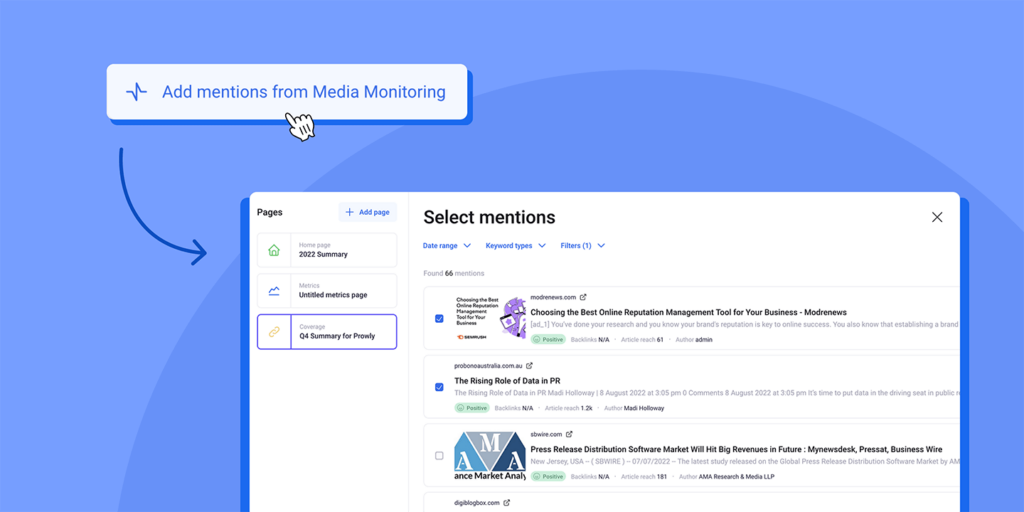
We listed many pieces of the PR puzzle above, so if you need more guidance on:
👉 PR campaign monitoring, check out our article on: How to measure PR success step by step.
👉 creating more comprehensive media reports faster, read this article.
#4 Experiential media engagements
Take a look at your public relations planner and add some exclusive media events or press tours to provide journalists with a top-notch, live experience of your brand.
By doing so, you can try to leave a lasting impression and become the top of mind brand.
📱 Generate some buzz among the social media world via influencers. Such events may also be a nice way to start some influencer collaborations.
👄 Deliver full-sense experiences by providing tastes, demos, or behind-the-scenes tours to get journalists some exclusive content.
#5 Crisis response training and simulation
Practice makes perfect, so go over some regular crisis simulation exercises. These will allow you and your teams to test the effectiveness of your responses.
- Conduct some training sessions not only for the regular employees, but also for your top-level and spokespeople.
- Simulate realistic crisis scenarios to test preparedness, decision-making, and communication skills under pressure.
#6 Global media engagement and localization
Are you going global?
Tailor strategies for international markets, keeping cultural differences and media landscapes in mind.
- Connect with regional media outlets, journalists, and influencers.
- Adapt your messaging and content for each of your regions, but at the same time, keep consistency in all your brand messaging.
Try Prowly's media database to find the right media contacts in the new localization. You can filter over 1 million positions by language, topics covered, country, and more.
#7 Leveraging advanced tools and tactics
✔️ Discover media monitoring and analysis tools to leverage real-time tracking of coverage, sentiment, and emerging trends.
✔️ Benefit from AI assistants and machine learning to automate media outreach, identify influencers, and enhance engagement strategies.
✔️ You can also implement agile project management methodologies to streamline workflows, adapting swiftly to evolving media landscapes, and thus achieve results more efficiently.
How to use AI assistant to strengthen your media relations strategy?
Creating pitches with AI won't be big news if you are pitching journalists traditionally on a daily basis. But it would be much faster. How does the process look?
#1 Step: Making your press release shine
The whole process is short, simple and tailored to PR needs. We can break it down to three key steps:
1️⃣ Enter basic details about your pitch
To get AI-generated content, first select the type of your press release. You can choose from a few types listed below, or choose your own.
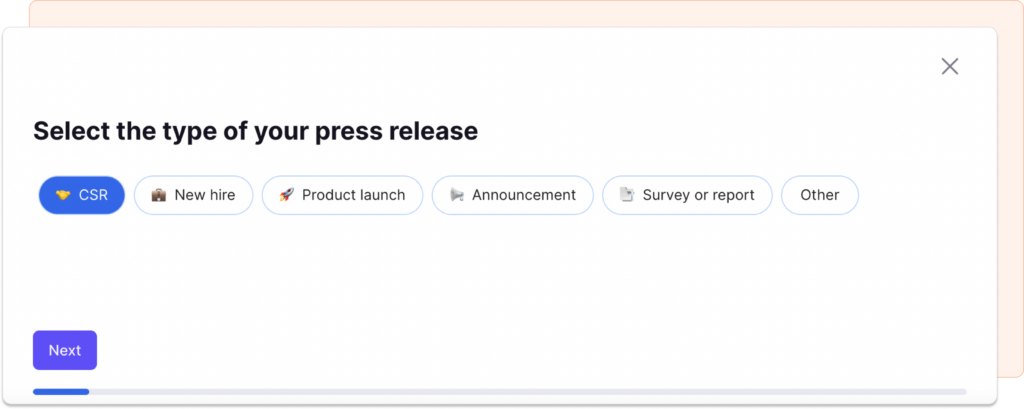
2️⃣ Answer relevant questions
You will now be presented with 10 detailed follow-up questions. The more precise you are, the better the result.
3️⃣ Set tone and voice
Selecting the right voice and tone is crucial for maximizing your message's impact and clearly communicating your intentions.
#2 Step: Automatic contacts proposal
Once you've written your story, it's time to shine. Find potential contacts to pitch to.
Simply input your initial 100 words and it will suggest journalists based on the keywords of your release.
Handy, isn't it?
This accelerates the whole process, eliminating the need for manual searches through our database. A reminder, there are over 1 million contacts.
While the database offers a vast selection, finding the ideal match may take some time.
However, armed with contact information, you can delve deeper into individuals’ interests and their previous work. This will help you tailor your pitches effectively.
#3 Step: Pitching process made easier
Once your press release is ready, it's time to pitch it.
Go to the "Emails" section, choose your recipients, and attach or embed your piece.
You can write your pitch from scratch, but Prowly's AI can draft an email for you.
👉 It is done based on your press release, providing your four key messages in bullet points. This way, it is easy for journalists to scan for newsworthy parts.
AI-driven pitching ensures clear and engaging communication, minimizing errors and enhancing relevance. Moreover, it saves you time, turning hours of work into seconds.
However always remember to check the final copy and adjust it. AI can be a great help, but it can only be successful when combined with human touch. Personalization is are everything.
💡 Extra tip: Use AI assistant to customize and edit the press release draft
What's more - Prowly's AI assistant can help you rewrite sections that lack that magic sparkle. ✨
You can simply upload your draft, and improve its quality before sending it to your stakeholders for approval or client.
Just choose whether you want to enchance a whole paragraph or just one sentence.
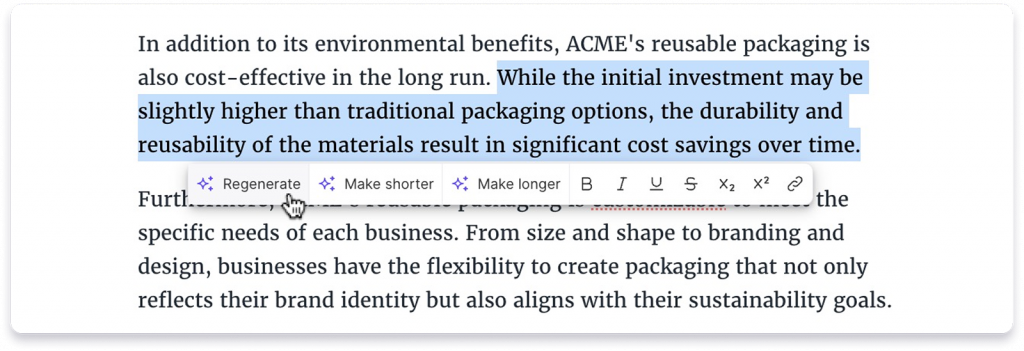
3 media relations strategy examples to copy
#1 Thought leadership campaign
How-to: Write thought-provoking articles, op-eds, and guest contributions for leading industry publications.
🎯 The goal: To establish top-level executives with expertise as respected and influential individuals in the industry.
- Research first. Identify trending topics and gaps in industry discourse.
- Create compelling thought leadership pieces that provide unique perspectives or useful insights.
- Use Prowly PR software to create media lists of relevant journalists and publications.
- Personalize pitches to journalists. Highlight the content's relevance and value.
- Monitor media coverage and engagement metrics to measure the impact of the campaign.
Outcome: Boost in visibility, credibility, and recognition for your executives and your brand. This can then lead to enhanced media relationships and opportunities for future coverage.
#2 Product launch media blitz
How-to: Coordinate a strategic media blitz across various channels and platforms to maximize outreach and influence.
🎯 The goal: To generate buzz and media coverage for a new product or service launch.
- Create a thorough press kit comprising press releases, product images, fact sheets, and spokesperson bios. All the essentials.
- Utilize Prowly PR software to create multimedia-rich press releases. Distribute them to tailored media lists.
- Conduct targeted media outreach with personalized pitches, briefings, and exclusive previews for key journalists.
- Coordinate social media amplification alongside traditional outreach to boost visibility.
- Monitor media coverage, SM mentions, and website traffic to assess campaign success.
Outcome: Extensive media coverage, heightened brand awareness, increased product visibility, and potential sales uplift.
#3 Crisis communication management
How-to: Use proactive and transparent communication to address your audience and stakeholder’s concerns and take control of the narrative.
🎯 The goal: To minimize reputational damage and maintain trust during a crisis or challenge.
- Develop a crisis communication plan with key messages. Establish spokesperson roles and escalation procedures.
- Use Prowly PR software to create a dedicated crisis communication hub for centralized updates.
- Monitor social media, news, and online forums for emerging issues and sentiment trends.
- Provide timely updates to media, employees, customers, and stakeholders, showing accountability and commitment.
- Conduct post-crisis analysis to learn from the experience and improve future strategies.
Outcome: Lower reputational damage, restore stakeholder confidence, and enhance resilience against future crises.
Frequently asked questions about media relations strategy
💬 What is media relations?
Media relations refers to managing relationships between a company and members of the media, such as journalists and editors.
This includes activities such as drafting press releases, arranging interviews, and responding to media inquiries.
💬 What is the purpose of a media relations plan?
The purpose of such a plan is to strategically manage relationships with the media.
The main focus is to communicate set objectives, such as increasing visibility, shaping PR, managing brand or executive reputation, and building relationships.
💬 What is a media relations strategy?
Media strategies outline how an organization will engage with the media to achieve its communication goals.
A successful media relations strategy: summing up
Creating a media relations strategy is a long-term investment from which your company may benefit for years. Building and enforcing relationships with the media should be your focus if your company's PR and image are vital parts of your strategy.
Maintaining such relationships is not an easy job to do, so there are several tactics to help keep things afloat. You can easily conduct the whole process with Prowly's assistance.
